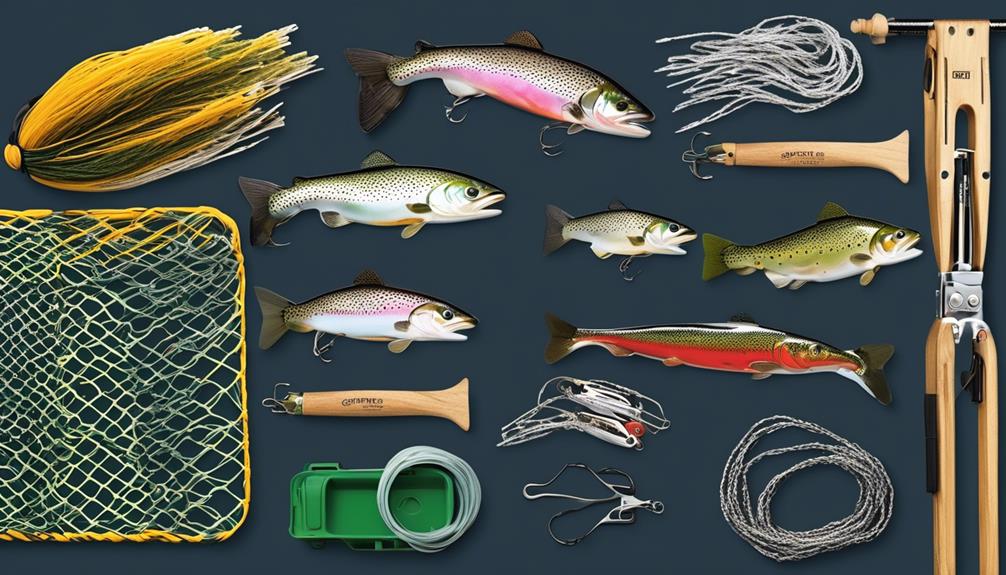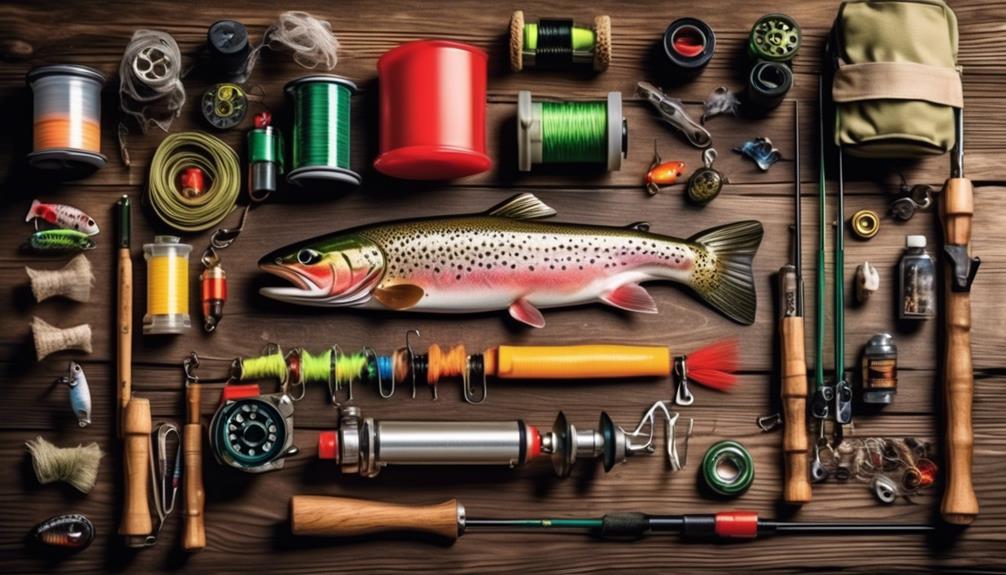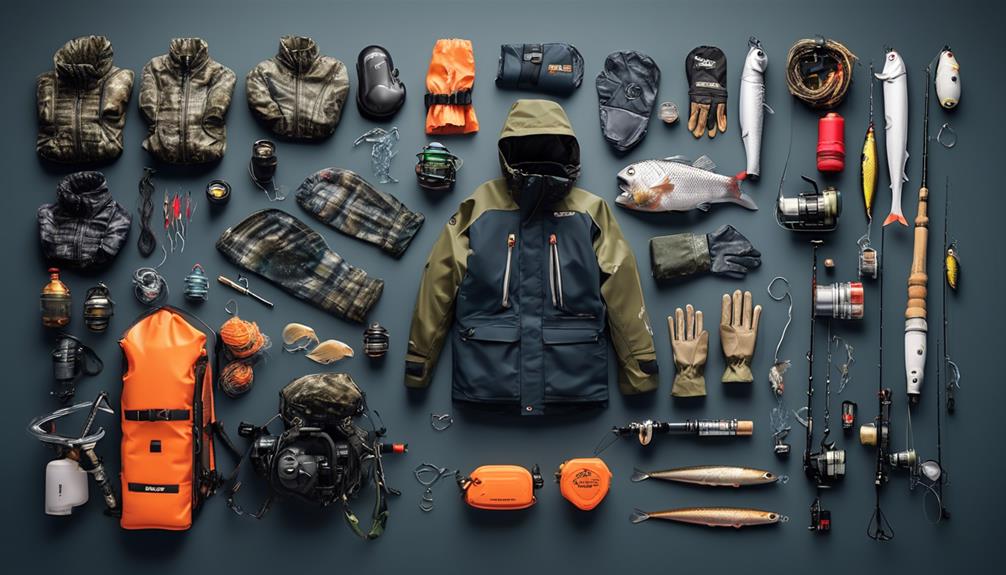If you're venturing into the world of trout fishing, you know the importance of having the right gear for a successful day on the water. From the rod in your hand to the tackle in your box, each item plays a crucial role in your pursuit of these elusive fish.
But with so many options available, how do you know which trout fishing tackle items are truly essential for your next angling adventure? Well, let's just say that the top 15 recommended items might surprise you.
Rod and Reel Combos
When choosing rod and reel combos for trout fishing, consider the weight and action of the rod to match the type of fishing you plan to do. For casting techniques and maintenance, it's essential to select a rod with the appropriate action.
A fast action rod provides greater sensitivity and is suitable for long-distance casting, making it ideal for fly fishing or casting lures. On the other hand, a medium or slow action rod is better suited for fishing in smaller streams or rivers where shorter, more accurate casts are required.
Regular maintenance of the rod is also crucial to ensure its longevity and performance. Wiping down the rod after each use and storing it properly can prevent damage and corrosion.
When it comes to reel types and maintenance, there are various options to consider. For trout fishing, a spinning reel is commonly used due to its versatility and ease of use. Spinning reels are suitable for various casting techniques, including bait fishing, lure fishing, and even fly fishing with the use of a fly reel.
Proper maintenance of the reel involves cleaning and lubricating its components to ensure smooth operation and prevent rust or corrosion. Additionally, checking the drag system and line regularly is essential to avoid any issues during fishing.
Fishing Line
Consider the pound test and type of fishing you'll be doing when selecting the right fishing line for trout fishing.
There are three main types of fishing lines to consider: monofilament, fluorocarbon, and braided lines.
Monofilament lines are popular for trout fishing due to their stretch, which can be beneficial when fighting trout in fast-moving water. They're also more affordable and have good knot strength. However, monofilament lines can be prone to abrasion and have more line memory, which can affect casting and line management.
Fluorocarbon lines are virtually invisible underwater, making them ideal for clear water conditions. They also sink faster, which can be advantageous for nymph and streamer fishing. On the downside, fluorocarbon lines tend to be stiffer and more expensive.
Braided lines are known for their strength and thin diameter, allowing for longer casts and better sensitivity. They also have minimal stretch, which can be useful for detecting subtle bites. Yet, braided lines are highly visible in clear water and can be more challenging to tie knots with.
When choosing a fishing line for trout, weigh the pros and cons of each type against the specific conditions and fishing techniques you plan to use.
Hooks and Lures
To effectively equip yourself for trout fishing, selecting the right hooks and lures is crucial for enticing and catching these elusive fish. When it comes to lure selection, it's important to have a variety of options to adapt to different conditions and trout preferences. Here are some essential tips for selecting lures:
- Consider the Water Conditions
- Pay attention to the water clarity and depth. For clear water, go for natural-looking lures, while in murky water, opt for brighter or more contrasting colors to grab the trout's attention.
- Match the size of the lure to the size of the baitfish in the area. Trout are more likely to strike at something that closely resembles their natural prey.
- Choose the Right Hook Types
- Single hooks are great for catch and release as they reduce injury to the fish.
- Treble hooks can increase your chances of hooking a trout due to having three points, but they can also cause more damage, so consider the environmental impact and regulations.
- Experiment with Different Lure Types
- Spinners and spoons are effective in fast-moving waters, as their spinning and wobbling motions mimic disoriented baitfish.
- Soft plastic baits like worms and grubs are versatile and can be used in various fishing techniques such as drop shot, Carolina rig, or just with a traditional hook and weight setup.
Remember to check your local regulations for any restrictions on hook types and lure usage, and always practice responsible and sustainable fishing techniques.
Bait and Attractants
Selecting the right bait and attractants is essential for increasing your chances of successfully luring in trout during your fishing expeditions. When it comes to bait, you have the choice between artificial and natural options.
Artificial baits such as plastic worms, spinners, or spoons can be effective as they come in various colors and designs that can mimic the appearance of natural prey. They're also reusable and don't require refrigeration.
On the other hand, natural baits like nightcrawlers, minnows, or insects can be irresistible to trout due to their authentic scent and appearance.
In terms of attractants, you'll need to decide between scented and unscented options. Scented attractants are formulated to mimic the natural scents of baitfish, insects, or other trout prey. These can be particularly useful in attracting trout, especially in muddy or murky waters where visibility is limited.
On the other hand, unscented attractants rely on visual appeal or sound to attract trout. They often come in the form of flashy spinners or lures that create vibrations and movements in the water to entice fish.
Ultimately, the choice between artificial and natural bait, as well as scented and unscented attractants, depends on the fishing conditions and the behavior of the trout in your area. Experimenting with different options and observing what works best in different situations will help you refine your bait and attractant selection for successful trout fishing.
Floats and Bobbers
When fishing for trout, using floats and bobbers can enhance your ability to detect bites and keep your bait at the desired depth. Different types of floats can be used, each serving a specific purpose. Traditional bobbers are fixed to the fishing line and are great for beginners as they're easy to set up and use. On the other hand, slip bobbers slide along the line, allowing you to adjust the depth of your bait without having to retie your rig. They're ideal for fishing in deeper waters where trout tend to reside. When choosing a float, consider the water conditions and the behavior of the trout you're targeting.
Trout fishing techniques using floats and bobbers can vary depending on the fishing environment and the behavior of the fish. Here are some tips to maximize your success:
- Adjust the depth of your bait by sliding the slip bobber along the line. This allows you to present your bait at different depths until you find where the trout are actively feeding.
- Use a sensitive float to detect subtle bites. When a trout takes your bait, the float will bob or twitch, indicating a potential bite.
- Experiment with different types of floats to find the most effective one for the specific fishing situation. Different floats have different buoyancy and visibility, so it's essential to test out a few options to see what works best for you.
Nets and Tackle Storage
Consider using a durable fishing net to safely land and handle trout without causing harm to the fish. When choosing a net, opt for a rubber or silicone material to prevent damaging the trout's delicate scales and fins. These materials are also easier to clean and maintain, ensuring that your net remains in good condition for years to come. Regular net maintenance is essential to prevent the spread of diseases between fish populations, so be sure to clean and disinfect your net after each use.
In addition to nets, tackle organization is crucial for a successful trout fishing trip. Invest in tackle storage solutions such as tackle boxes or bags with multiple compartments to keep your gear organized and easily accessible. This will save you time and frustration on the water, allowing you to focus on the thrill of catching trout.
When storing your fishing tackle, consider the materials used in the storage solutions. Look for durable, water-resistant options to protect your gear from the elements. Hard plastic tackle boxes are a popular choice for their durability and ability to keep your tackle safe and secure. Soft tackle bags are also a great option, providing flexibility and mobility while still offering ample storage space for your trout fishing essentials.
Tools and Accessories

To ensure your success in trout fishing, equip yourself with the necessary tools and accessories for a productive and enjoyable angling experience. Here are some essential items to consider:
- Tackle Organization
- *Tackle Box*: Invest in a quality tackle box with adjustable compartments to keep your lures, hooks, and other small items organized and easily accessible.
- *Tippet Spool Holder*: Keep your tippet spools neat and tangle-free with a convenient spool holder that can be attached to your vest or bag for quick access.
- *Retractable Gear Tether*: A retractable gear tether is perfect for securing essential tools such as line clippers, forceps, or nippers, keeping them within reach while preventing loss.
- Fly Tying
- *Fly Tying Vise*: For anglers interested in creating their own flies, a fly tying vise is a crucial tool for securing the hook while you work on the intricate details of your custom flies.
- *Fly Tying Materials Kit*: A comprehensive fly tying materials kit containing feathers, threads, and other essential elements will enable you to craft a wide variety of effective fly patterns.
- *UV Resin and Cure Light*: Enhance the durability and realism of your flies with UV resin, and expedite the curing process with a specialized UV cure light.
Having these tools and accessories at your disposal won't only streamline your trout fishing experience but also provide the necessary support for activities such as tackle organization and fly tying.
Clothing and Footwear
Make sure your clothing and footwear are suitable for the varying conditions you may encounter while trout fishing. Waterproof gear is essential for comfort and protection. When fishing for trout, you may face changing weather conditions, including rain or splashing water from the river. Therefore, wearing waterproof clothing such as a jacket and pants will keep you dry and comfortable throughout your fishing trip. Look for breathable materials to prevent overheating, especially if you're actively moving around while fishing.
Proper footwear is crucial to ensure safety and stability while wading. The terrain around rivers and streams can be slippery and uneven, so having the right footwear is important. Invest in a good pair of wading boots with felt or rubber soles to provide traction and prevent slipping on rocks or moss-covered surfaces. These boots should also provide ankle support and be comfortable for long periods of wear.
Additionally, consider wearing moisture-wicking socks to keep your feet dry and prevent blisters, especially if you'll be spending extended periods in the water.
Frequently Asked Questions
Can Trout Fishing Tackle Items Be Used for Other Types of Fishing as Well?
Yes, trout fishing tackle items can be versatile for other types of fishing as well. The fishing equipment and gear used for trout fishing can often be adapted for different fishing techniques and strategies.
With proper tackle maintenance, you can optimize your gear for various fishing locations and species. So, while these items are recommended for trout fishing, they can also be utilized for other types of fishing with some adjustments.
Are There Any Specific Regulations or Guidelines for Using Certain Types of Bait or Lures When Fishing for Trout?
When fishing for trout, regulations and restrictions on bait and lures are put in place to protect the fish population and their environment. Using certain types of bait or lures may be prohibited in specific areas to conserve the trout population and minimize the environmental impact.
It's important to familiarize yourself with local regulations before heading out to fish for trout, as violating these rules can result in fines or penalties.
How Can I Properly Store My Trout Fishing Tackle Items to Ensure They Last for Multiple Fishing Trips?
To properly store your trout fishing tackle items for multiple trips, ensure they're clean and dry before storage. Use tackle boxes or bags to keep everything organized and protected.
Store items in a cool, dry place to prevent rust or deterioration. Regularly check for any signs of wear or damage and perform maintenance as needed.
This proper storage and maintenance will extend the longevity of your tackle, keeping it in top condition for many fishing trips.
Are There Any Specific Tools or Accessories That Can Help Improve My Chances of Catching Trout?
To improve your chances of catching trout, consider incorporating specific tools and accessories into your tackle. These can help enhance your effectiveness in the water.
Additionally, staying on top of trout fishing gear maintenance is crucial for ensuring your equipment lasts through multiple fishing trips.
What Type of Clothing and Footwear Is Best Suited for Trout Fishing in Different Weather Conditions?
For trout fishing in different weather, it's essential to have weather-appropriate clothing and the best footwear.
In cold and wet conditions, go for waterproof and insulated clothing, and durable, waterproof boots to keep your feet warm and dry.
For warmer weather, breathable and lightweight clothing is ideal, and consider sturdy, non-slip shoes for rocky terrains.
Proper attire helps you stay comfortable and focused on reeling in those trout.
Conclusion
So there you have it, the top 15 recommended trout fishing tackle items to make your next fishing trip a success.
- With the right rod and reel combo
- Fishing line
- Hooks and lures
- Bait and attractants
- Floats and bobbers
- Nets and tackle storage
- Tools and accessories
- Proper clothing and footwear
With these items, you'll be fully equipped to reel in those beautiful trout.
Happy fishing!



